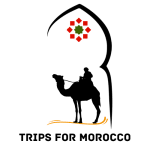The indigenous people of Morocco
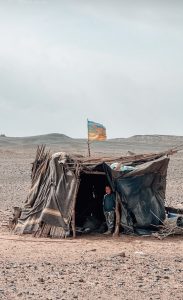 Mainly Berbers are the first inhabitants of Morocco, not only Morocco but all the north Africa, from the Canary islands east, Siwa Oasis in Egypt west, to Niger West. Their original name is Amazigh or Imazighen, which means Free People, the nickname of Berber came from the when the Romans came to North Africa used to call anyone does not speak Latin as Barbarian and later the name became Berber.
Mainly Berbers are the first inhabitants of Morocco, not only Morocco but all the north Africa, from the Canary islands east, Siwa Oasis in Egypt west, to Niger West. Their original name is Amazigh or Imazighen, which means Free People, the nickname of Berber came from the when the Romans came to North Africa used to call anyone does not speak Latin as Barbarian and later the name became Berber.
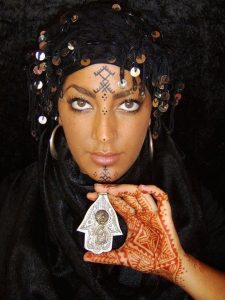
They lived in many separated communities across Morocco among them, Mauritania, Algeria, Tunisia, Libya, Niger, Egypt and Mali. Berbers speak many varieties of Amazigh languages that belong to the Afro-Asiatic languages, related to Egyptian, Kushites, Levantine tribes. Amazigh flag contains three main colors and the Letter Z in Berber alphabet. These colors and symbol hold the meaning of. Yellow represents the desert. The green represents the mountains. the Blue represents the ocean and sea. The symbol ⵣ refers to resistance and free men of the Imazighen. Berber language is called as miracle language because it is the last language left from the languages that squeezed the Phoenician, Roman language, and Carthaginian and many other old languages. One of the main traditional for Berber women is the face tattoos by Henna that women used to make as a sign of beauty. And wearing a decorated scarf that on their heads that are made by themselves.
Moroccan History
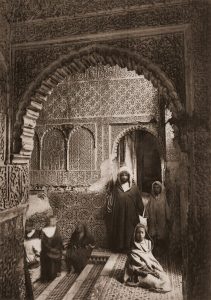 The kingdom of Morocco is a country among the Maghreb region of North Africa. Morocco is in the borders from Algeria in the east and southeast, the Western Sahara in the south, the Atlantic Ocean in the west, and the Mediterranean Sea in the north. Morocco ruled by six main dynasties. the First of them was the Idrisside dynasty from 789 to 978 leaded by Idriss I who made Volubilis or Oualili as the capital. After the Idrisside, the ruling went to Almoravid dynasty from 1060 to 1147 who found Marrakech and made it as the capital and a main site of trading between the Maghreb and sub Saharan Africa. The dynasty fell from the Almoravids to the Almohads, a new dynasty that ruled from 1145 to 1248, leaded by Ibn Toumert. Later on the Marinids won over the Almohads and they became the conquering dynasty of the country, but they did last too long because they were defeated by the Portuguese.
The kingdom of Morocco is a country among the Maghreb region of North Africa. Morocco is in the borders from Algeria in the east and southeast, the Western Sahara in the south, the Atlantic Ocean in the west, and the Mediterranean Sea in the north. Morocco ruled by six main dynasties. the First of them was the Idrisside dynasty from 789 to 978 leaded by Idriss I who made Volubilis or Oualili as the capital. After the Idrisside, the ruling went to Almoravid dynasty from 1060 to 1147 who found Marrakech and made it as the capital and a main site of trading between the Maghreb and sub Saharan Africa. The dynasty fell from the Almoravids to the Almohads, a new dynasty that ruled from 1145 to 1248, leaded by Ibn Toumert. Later on the Marinids won over the Almohads and they became the conquering dynasty of the country, but they did last too long because they were defeated by the Portuguese.
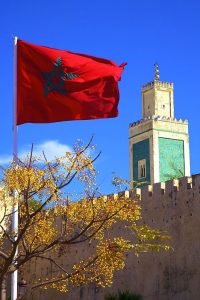
This dynasty lasted from 1244 to 1465, and Fes was the capital of the Marinids. After the Marinids, a new dynasty began the ruling in the country called Saadian dynasty from 1554 to 1659. They build many artistic and religious artefacts, for example in Fes the Borjs and renewal of the Qarawiyine mosque.
In Marrakech they built tombs of the Saadians, El Badii Palace, and also the Ben Youssef Medrassa. The current dynasty in Morocco which is Alaouite dynasty that originally from Tafillalt that is located in the south east of Morocco. The Alaouites started ruling since 1666 to the present day.
The main flag of Morocco contains of the red field that represents the blood of the predecessors and the unity. And a green pentagram that represents the five pillars of Islamic religion. Concerning the religion in Morocco, Islam is the predominant in the country, with some of the population adhering the Sunni branch. Morocco is very known by the cultural diversity influenced by the Arab, Berber, European and African cultures and traditions. Morocco is a popular tourist destination, attracting visitors with its historic cities, stunning landscapes, and unique cultural experiences. Cities like Marrakech and Fes are known for their historic medinas (old towns), while coastal towns like Essaouira offer beautiful beaches and a relaxed atmosphere. The Sahara Desert in southern Morocco is another major attraction, where travelers can experience camel treks and the unique desert environment.
FAQ
Who were the indigenous people of Morocco, and what role did they play in Morocco’s history?
The Berbers, or known as the Amazigh people or the free people, are the native inhabitants of Morocco. They have a rich and varied history that predates the advent of Arabs and other outside influences. They are the indigenous people of all North Africa, Egypt, Algeria, Tunisia and many others including also modern-day Morocco.
Are there any historical or archaeoligical sites or projects that can travellers support ?
There are several ongoing archaeological and historical preservation projects in Morocco that travelers can visit or support. These projects aim to conserve and promote Morocco’s rich cultural heritage for future generations. such as Volubilis, Medinas…ect. By participating in cultural activities, and supporting local initiatives, travelers can contribute to the preservation and promotion of Morocco’s rich archaeological and historical heritage.
What was the impact of the french colonization on Morocco ?
Morocco took its independence from France in 1956 after 44years of conquering the country. However, French people left a big impact on Morocco society, culture, language, economy, and not to forget the language as we still see the french language spread all around Morocco.
Do Berber people speak Arabic ?
Berber and Arab people have coexisted for many centuries, resulting in cross-cultural interactions and marriages. Arabic was adopted by many Berbers for pragmatic reasons as it became the primary language of trade, administration, and religion in the region over time. And also the Berber language was taught in the schools that is why the children had to speak Arabic for education reasons.
Do Berber people have the same culture of the Arab culture ?
Berbers have many things in common with the Arabs such as religion, celebrated events, and many others. However, Berbers can have many cultural traditions, and events that are dedicated only for Berbers and are totally different from the Arab ones. Such as the Amazigh new year, the food, and others.
What was the significance of the Green March in Moroccan history ?
After Morocco took its independence from France in 1956, Morocco consistently asserted its claim to the Spanish Sahara, now known as Western Sahara. In November 1975 the king at that time Hassan II called for a “Green March” of 350,000 unarmed Moroccans. This claim was rooted in the historical allegiance of local nomadic populations in the region to the Moroccan monarchy. Also this historical event symbolizes the determination, unity, and peaceful resolve of the Moroccan community.
Is Morocco a safe country for non-muslims ?
One of the reasons that made Morocco a preferred destination for travellers is because it is an open country and very safe for non muslims to travel. The United States is considered as a land of diversity because many ethnic groups live side by side. Morocco as well is considered a small version of the United States, as Morocco contains many synagogues and Churches . Non muslims have the freedom to wear and do whatever they want.
Who is the queen of Morocco ?
The current queen of Morocco is Lala Salma Bennani who was born in Fes, 1978. But in Morocco always the wife of the king is called the princess rather than the queen, due to the system of the Moroccan Monarchy in which the females can not rule the country. As the throne is always passing through the males. The old son of the king. If the king has no sons it goes to his brother.
What are the official languages in Morocco ?
Before 2011 Arabic and French were the official languages in the Moroccan constitution. Berber or Amazigh language was non official, until the adoption of the 2011 constitution. Now you can find all three languages in school, streets signs.
How did Islam entered to Morocco ?
Islam was to begin with brought to Morocco in the 7th century. by a Middle easterner intrusion beneath the Uqba ibn Nafi, who was a common serving beneath the Umayyads of Damascus. In 788, The Shia Idrisids who embraced master Zaydi ruled expansive parts of Morocco. Their counterparts included the sinful Barghawata state and the Khariji state of Sijilmasa. After a few Berbers shaped more effective Islamic traditions that ruled over the nation.
